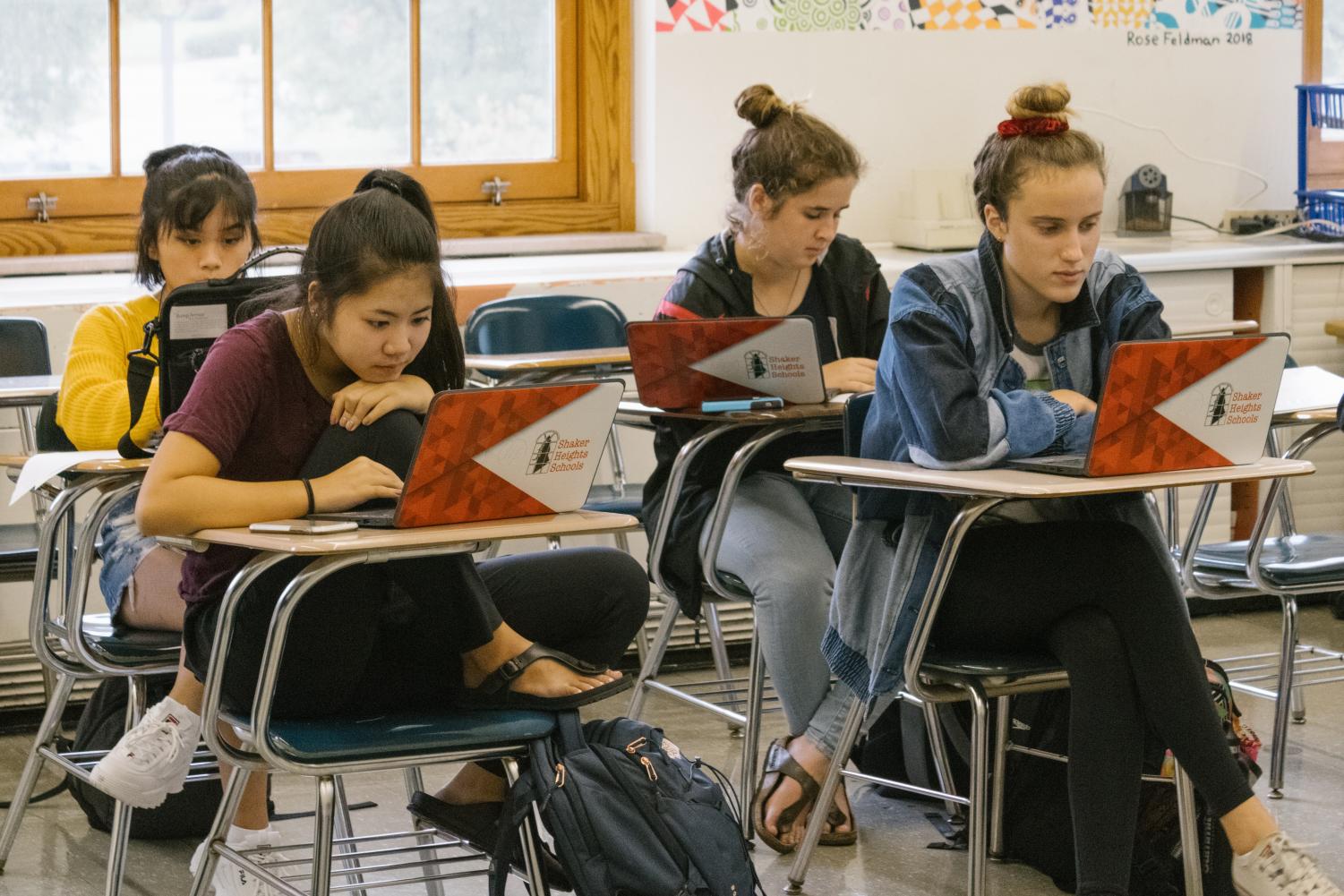Administration Implements 1:1 Chromebook Plan
New laptops give Shaker students access to technology at home and school.
September 13, 2019
For the first time, students in grades five through 12 received district-issued Chromebooks when school began.
The district implemented a 1:1 Chromebook-to-student plan for this school year. According to John Rizzo, director of technology and media services, the decision was made during the 2017-18 school year.
The purpose of the program is to provide all students with the same Chromebook device to maintain consistency in teacher lesson planning and to provide equal access to beneficial learning tools for all. “Not having a 1:1 ratio created a hindrance when attempting to integrate technology into lessons,” Rizzo wrote in an email, explaining input he received from Shaker staff. “When relying upon carts of shared devices, teacher and student use per classroom was dependent upon cart availability,” he wrote. “This structure created an uncertainty that devices would be available and often deterred teachers from regularly creating/modifying lessons to include technology.”
Rizzo also wrote that teachers were concerned from an equity standpoint about the range of different devices in the classroom, or some students not having them at all.
Dr. David Glasner, superintendent, said the program is not specifically about Chromebooks. “It’s about making sure our students are equipped with the tools they need to be successful in school and outside of school,” he said.
According to Rizzo, the district spent approximately $580,000 on Chromebooks and chargers and $53,000 on protective carrying cases.
According to Glasner, Chromebooks can also be used for online standardized testing, although, he said, this was not the reason for purchasing them. “In the past, we’ve had some real struggles just being sure that we have enough devices to get to students,” for testing, Glasner said. “And then we end up having to be very creative, putting hundreds of students together in one room and totally rechanging the school schedule to accommodate those changes.”
Students bear no cost for the Chromebook, charging cable or protective carrying case, but families are encouraged to purchase a $25 protection plan that covers the cost of a lost or damaged device. The plan, called the One2One Protection Plan, can be purchased through each family’s school PayForIt account. Families pay the $25 fee for each child’s Chromebook. The charging cables and protective carrying cases cost $30 each to replace or repair and are not covered by the protection plan.
Without the plan, a Chromebook will cost $274 to replace and $30 to repair.
A 1:1 core planning committee was created in 2018 comprising three Woodbury, four middle school and five high school staff members, along with Glasner, Rizzo and the members of the IT department. The focus of this group was to finalize all components of the 1:1 program in order to ensure its success in the district. According to Rizzo, the team will continue to meet this school year and in the future to refine the program, discuss its issues and share its successes. In 2018, Rizzo also regularly met with a group of high school students who gave him feedback on the 1:1 planning process.
The high school has 10 mobile hotspot devices, called Kajeet SmartSpots, that are available for students to check out from the school library for use at home. The devices provide WiFi for students who do not have reliable access at home. The Kajeet SmartSpot was created for school-related purposes and includes internet filtering. “They are meant to support a student’s academic work,” Rizzo wrote.
In 2017, G Suite for Education was introduced in the district to promote online collaborative work among teachers and students. It comprises Google Classroom, Google Drive, Google Docs, Google Sheets and Google Slides.
As part of G Suite, teachers were given Chromebooks for their professional use, attended training on Google Suites and passed the Google Certified Educator Level One Exam. “Multiple training options were provided to faculty and staff,” Rizzo wrote, “ranging from two-day bootcamps to self-guided study.”
The Federal Children’s Internet Protection Act requires school-distributed devices to contain web filtering inside and outside of school.
Accoring to the CIPA website, the act requires schools to institute internet safety policies, which prohibit access to inappropriate websites for minors; protect the security of minors when communicating online; block hacking or unlawful activity, including unauthorized disclosure of a minor’s information; and restrict websites that can be considered dangerous to minors. However, CIPA does not require that internet browsing be monitored, and the district can choose to unblock certain websites.
According to Light Speed Systems, the district’s web filter, Web Filter 3, seal blocks websites categorized as offensive, pornographic or extremely violent. This means districts cannot unblock those sites. Some examples of website categories that are usually blocked include social media, drugs and alcohol, mature content and gambling.
The Information and Technology Department is in charge of blocking and unblocking websites. If a student or teacher discovers a site that they believe should not be filtered, a request can be sent to the IT department, and they will review the problem immediately. If the website is appropriate, it will be unblocked.
On Aug. 21, junior James Kennedy asked Principal Eric Juli to unblock YouTube because a video he had created for his APUSH class sophomore year had been filtered. Juli contacted the IT Department to unblock the misfiltered video. In the future, Juli said, teachers and students who encounter blocked sites should share that experience with him. “When they hit something that ought not to be blocked,” he said, he will “get it unblocked right away.”
